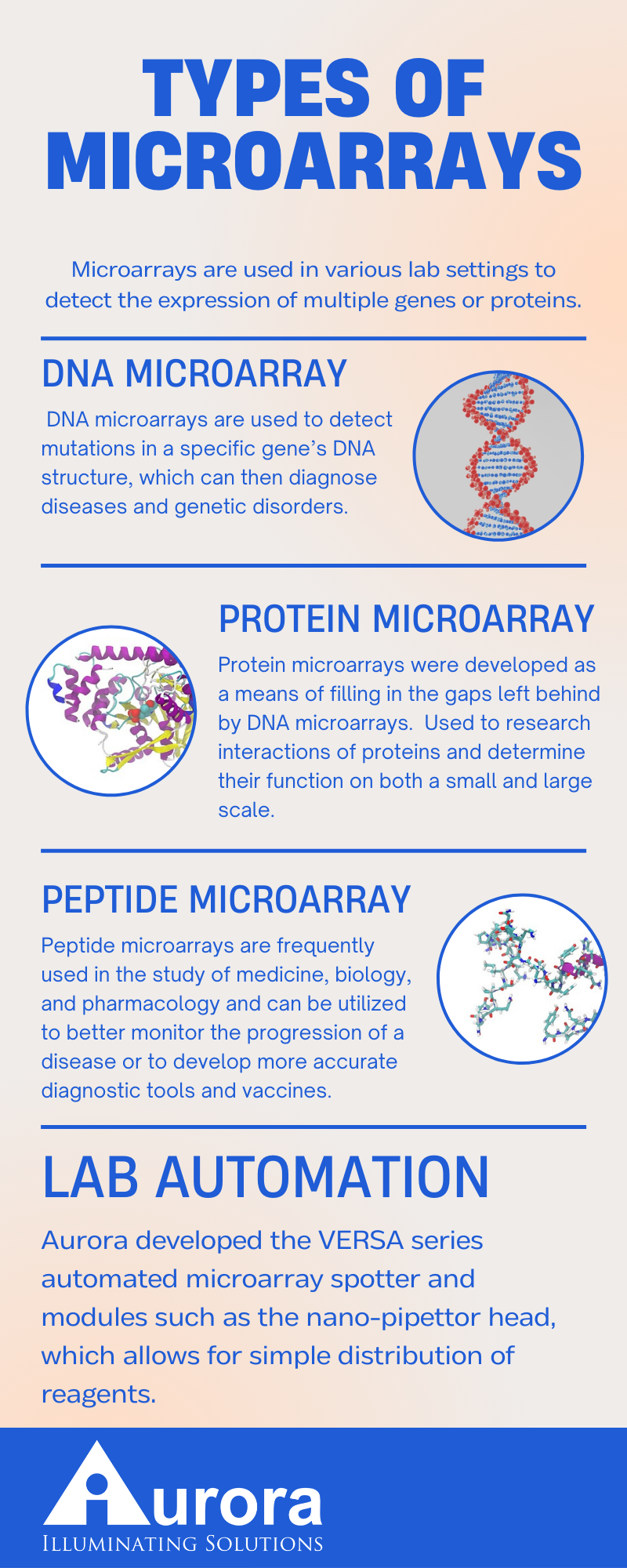
Microarrays are extremely minuscule yet highly complex laboratory tools which test large quantities of biological material. Microarrays are used in various lab settings to detect the expression of multiple genes or proteins simultaneously. Utilizing multiplexed parallel-processing methods, microarrays can increase throughput and produce larger amounts of data in a single experiment. While the methods and analysis techniques remain quite similar between all different types of microarrays, there are a few key differences in the purpose and applications for each microarray type.
DNA Microarray
Of the different types of microarrays, DNA microarrays are the most common. DNA microarrays are used to detect mutations in a specific gene’s DNA structure, which can then diagnose diseases and genetic disorders. To create these DNA microarrays, an analyst prints a small glass plate with thousands of short, single-strand DNA sequences which have been synthetically produced. DNA fragments from a patient’s DNA are then added to these synthetically produced sequences. Depending on which synthetic fragments the patient’s DNA binds to, the analyst is then able to detect and identify specific mutations within the patient’s DNA. DNA microarrays are most commonly used by medical professionals to research and identify various gene mutations—this allows medical professionals to better understand the role gene mutations play in the diagnosis of various diseases.
Protein microarray
Protein microarrays were developed as a means of filling in the gaps left behind by DNA microarrays. While DNA microarrays do provide scientists with important information regarding gene mutations, they do not always accurately reflect the expression levels of genes in a given cell. Thus, protein microarrays focus on the interactions of proteins, rather than the interactions of mRNA. Using many of the same techniques as DNA microarrays analysis, protein microarrays seek to track the interactions of proteins and determine their function on both a small and large scale.
Peptide microarray
Peptides and proteins are very similar, so it stands to reason that both the methods and applications for peptide microarrays and protein microarrays would also be quite similar. As with protein microarrays, peptide microarrays study protein-protein interactions. However, peptide microarrays focus more specifically on mapping antibody epitopes and finding residues for protein binding sites. Peptide microarrays are frequently used in the study of medicine, biology, and pharmacology and can be utilized to better monitor the progression of a disease or to develop more accurate diagnostic tools and vaccines.
Because this process is so minuscule and requires extreme attention to detail, it can be rather time-consuming. For this reason, many laboratories are turning to automated microarray spot printers to streamline the process. These systems also enable scientists to increase the screening throughput, allowing them to test more samples in one sitting. For more information about how automated workstations such as automated microarray spot printers and automated liquid-liquid extraction systems can help your lab, contact us.
Automated microarray spotter
Aurora has created an automated microarray spotter. You can set it and walk away, while reducing human error and contamination.



